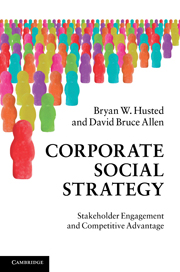Book contents
- Frontmatter
- Contents
- Figures
- Tables
- Acknowledgments
- 1 Introduction
- Part I Fundamentals
- Part II The process of developing corporate social strategy
- Part III Implementing social strategy
- 10 Organizing for social strategy
- 11 Corporate social strategy management and the multinational firm
- 12 Measurement and evaluation
- 13 The future of social strategy
- Bibliography
- Index
10 - Organizing for social strategy
Published online by Cambridge University Press: 05 June 2012
- Frontmatter
- Contents
- Figures
- Tables
- Acknowledgments
- 1 Introduction
- Part I Fundamentals
- Part II The process of developing corporate social strategy
- Part III Implementing social strategy
- 10 Organizing for social strategy
- 11 Corporate social strategy management and the multinational firm
- 12 Measurement and evaluation
- 13 The future of social strategy
- Bibliography
- Index
Summary
Internalizing social action
To increase a firm’s competitive advantage, social projects must be cost effective and produce a clear return on investment. The odds of success are higher when projects are strategically aligned with the business mission of the company, and the costs of implementing social activities are managed as they would be for other business investments. The strategic decisions facing senior managers are twofold: (1) which social activities are right for the company? and (2) how can social activities be managed to reduce costs? For example, stakeholders often ask publicly traded corporations to respond to issues such as AIDS research and homelessness. The decision to focus efforts on AIDS research rather than homelessness (or any number of other social ills) is the company’s choice. Once decided, the firm must then determine how it can be most effective. Shall the firm support research by other organizations through charitable contributions? Shall it undertake in-house research to find a cure? Or should the firm collaborate with a university to develop a joint program of research? The decision to outsource social activity through charitable contributions, internalize it, or collaborate with other organizations has important implications for the cost side of corporate social management. These alternatives represent issues of governance – i.e., how the company chooses to organize a particular activity in order to realize mutual gains for itself and its partners (Williamson, 1996).
The problem for senior management is to determine which governance structure or mode is most effective for organizing a particular social activity, e.g., in-house, outsourcing, or collaboration. This decision is important for several reasons. First, to be effective, social activities must be organized and managed to create the greatest social good at the least possible cost. Corporations cannot afford to waste resources, even those dedicated to discretionary, non-strategic activities. Second, the discretionary nature of much CSR activity lends itself to possible abuse, ranging from top management siphoning off money to their favorite causes to outright fraud. According to a report by the Association of Certified Fraud Examiners (2008), corporate fraud was estimated to amount to almost US$994 billion in 2008. Internal fraud is not the only concern. Firms must ensure that the non-profit recipients of donations do their work honestly and efficiently.
- Type
- Chapter
- Information
- Corporate Social StrategyStakeholder Engagement and Competitive Advantage, pp. 213 - 237Publisher: Cambridge University PressPrint publication year: 2010



